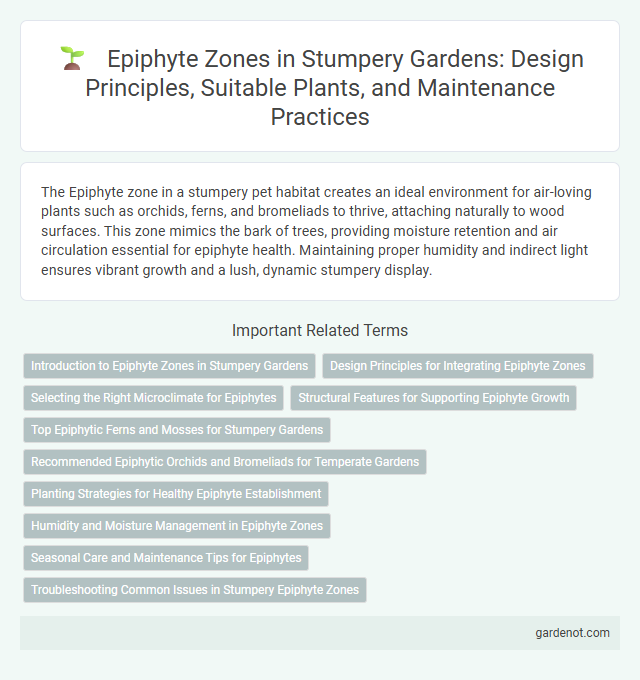The Epiphyte zone in a stumpery pet habitat creates an ideal environment for air-loving plants such as orchids, ferns, and bromeliads to thrive, attaching naturally to wood surfaces. This zone mimics the bark of trees, providing moisture retention and air circulation essential for epiphyte health. Maintaining proper humidity and indirect light ensures vibrant growth and a lush, dynamic stumpery display.
Introduction to Epiphyte Zones in Stumpery Gardens
Epiphyte zones in stumpery gardens create unique microhabitats that support diverse plant species such as orchids, ferns, and bromeliads thriving on decaying wood surfaces. These zones optimize moisture retention and nutrient cycling, enhancing overall biodiversity within the garden ecosystem. Integrating epiphyte zones promotes sustainable gardening practices by mimicking natural forest environments.
Design Principles for Integrating Epiphyte Zones
Epiphyte zones thrive by mimicking natural habitats, emphasizing vertical layering and diverse substrate textures to support mosses, ferns, and orchids. Incorporating moisture-retentive materials like cork or bark enhances humidity levels, essential for epiphyte health. Strategic placement ensures optimal light exposure and air circulation, fostering robust growth and ecological balance within the stumpery.
Selecting the Right Microclimate for Epiphytes
Selecting the right microclimate for epiphytes in a stumpery involves understanding their specific humidity, light, and airflow requirements to replicate their natural habitat. Epiphytes typically thrive in shaded, high-humidity environments with good air circulation, making north or east-facing stumpery zones ideal for maintaining moisture without direct sunlight. Monitoring temperature fluctuations and ensuring consistent moisture levels support healthy growth and prevent desiccation or fungal issues common in epiphytic plants.
Structural Features for Supporting Epiphyte Growth
The Epiphyte zone in a stumpery is characterized by a complex network of rough bark, twisting branches, and crevices that create ideal microhabitats for epiphyte establishment and growth. The structural features include moisture-retentive surfaces, shaded niches, and varied textures that facilitate attachment and nutrient absorption for mosses, lichens, and ferns. These elements promote biodiversity by providing stability and microclimates essential for epiphyte survival in the stumpery ecosystem.
Top Epiphytic Ferns and Mosses for Stumpery Gardens
The epiphyte zone of a stumpery garden showcases top epiphytic ferns such as Polypodium polypodioides and Asplenium nidus, thriving on decaying wood and shaded surfaces. Mosses like Hypnum cupressiforme and Dicranum scoparium provide a lush, carpeted texture that retains moisture and supports the micro-ecosystem. These plants enhance biodiversity while creating a naturalistic, layered aesthetic essential for a successful stumpery design.
Recommended Epiphytic Orchids and Bromeliads for Temperate Gardens
Recommended epiphytic orchids for temperate garden stumperies include species such as Dendrobium nobile, Epidendrum radicans, and Oncidium sphacelatum, known for their resilience and vibrant blooms. Bromeliads like Tillandsia ionantha, Guzmania lingulata, and Vriesea splendens thrive in cooler, humid conditions and add architectural interest with their striking foliage and inflorescences. These plants adapt well to shaded, moist environments typical of stumperies, enhancing biodiversity and visual appeal in temperate zones.
Planting Strategies for Healthy Epiphyte Establishment
In the epiphyte zone of a stumpery, selecting host logs with rough, moisture-retentive bark supports healthy root attachment and growth. Positioning plants in shaded, humid microclimates enhances moisture availability and reduces desiccation stress, crucial for epiphyte establishment. Incorporating slow-release organic fertilizers and regular misting encourages robust development and mimics natural epiphytic conditions.
Humidity and Moisture Management in Epiphyte Zones
Epiphyte zones require precise humidity and moisture management to support the growth of plants like orchids, ferns, and bromeliads that absorb water from the air. Maintaining consistent humidity levels between 60-80% and ensuring adequate air circulation prevents mold and rot while promoting healthy root respiration. Using misting systems and moisture-retentive organic materials such as sphagnum moss enhances water retention without waterlogging the epiphytes.
Seasonal Care and Maintenance Tips for Epiphytes
Epiphytes in the Epiphyte zone require regular misting and indirect light to thrive, especially during dry or low-light seasons. Seasonal care involves adjusting watering frequency to prevent root rot in winter while maintaining humidity during warmer months. Inspect plants for pests and prune dead material to promote healthy growth throughout the year.
Troubleshooting Common Issues in Stumpery Epiphyte Zones
Troubleshooting common issues in stumpery epiphyte zones involves monitoring humidity levels consistently, as inadequate moisture can cause epiphytes like orchids and bromeliads to wilt or lose vibrancy. Inspect for pests such as scale insects and mealybugs that thrive in the humid microclimate, applying horticultural oils or insecticidal soaps for control. Ensure proper air circulation around the roots and plant bases to prevent fungal infections and rot, which are common in dense stumpery environments.
Epiphyte zone Infographic

 gardenot.com
gardenot.com